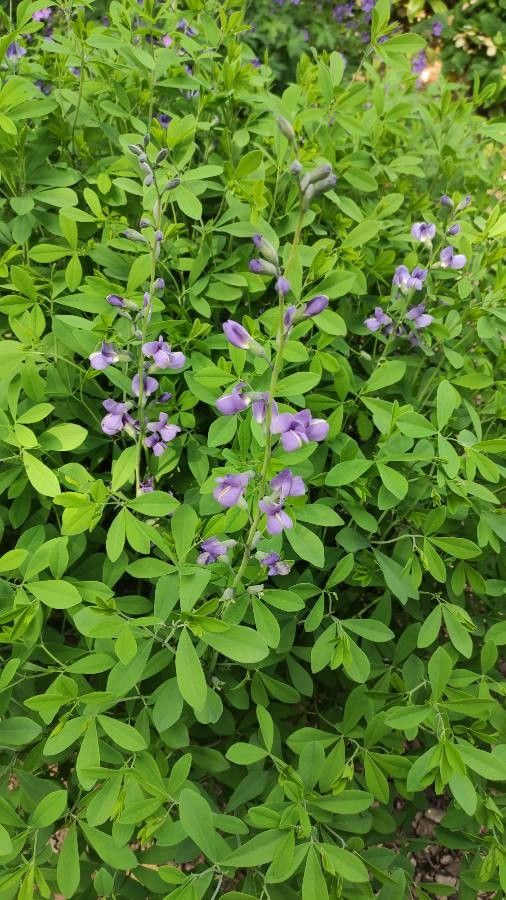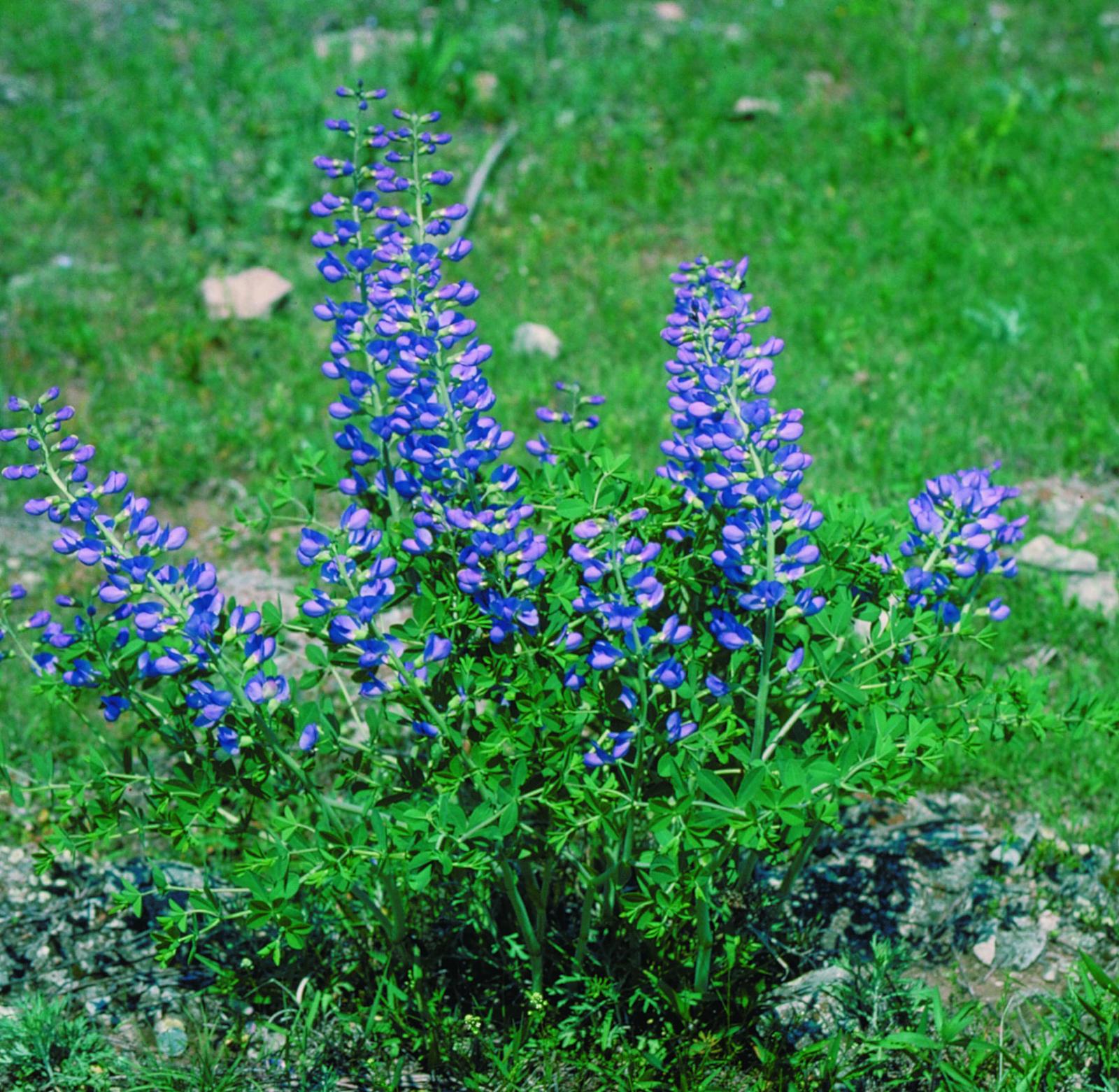Blue False Indigo
baptisia australis
Also known as: ["False Indigo","Wild Indigo"]
Overview
A hardy perennial legume with blue-green foliage and spikes of blue-purple flowers, native to North America.
Benefits & Perks
["long-flowering","disease resistant","deer resistant","wildlife attractant (bees, butterflies, birds)","drought tolerant","shade tolerant"]
Botanical Classification
| Phylum: | Magnoliophyta |
| Class: | Magnoliopsida |
| Order: | Fabales |
| Family: | Fabaceae |
| Genus: | Baptisia |
| Botanical Name: | Baptisia australis |
Plant Characteristics
Basic Information
- Category: Flowers
- Suitable Location: garden bed or border in full sun
- Suitable For:
- Is Weed: No
- Allergenicity: low
Environmental Needs
- Climate: {"temperatureRange":"–34 to 43°C"}
- Hardiness: {"zones":"3–9"}
- Misting: rarely required
- Drainage: Fast-draining to moderate-draining; avoid waterlogged conditions.
- Soil Type: Well-draining, loamy soil with organic matter; tolerates poor soils but thrives with added compost.
Maintenance Level
- Maintenance Level: low
- Toughness Level: high
- Pruning Frequency: Annually in late winter or early spring; remove spent flowers after blooming to tidy up.
- Pruning Intensity: Light to moderate; avoid heavy pruning as it can reduce flowering.
Care Details
Ideal Sunlight Coverage:
Full sun (6–8 hours of direct sunlight daily); tolerates partial shade but may produce fewer blooms.
Sunlight Tolerance Tips:
Acclimate plants gradually to intense sunlight; protect from harsh afternoon sun in hot climates; ensure adequate air circulation to prevent fungal issues.
Care Requirements
Care Difficulty
easymoderate
Sunlight
full sun
Rotate plants for even light exposure; use shade cloth in extreme heat; avoid placing in drafty areas.
Watering
every 2–3 weeks during active growth, less frequently in winter
Water at the base of the plant to avoid foliage; ensure soil dries slightly between waterings; avoid overwatering to prevent root rot.
Soil
well-drained, loamy soil with moderate fertility
pH: Slightly acidic to neutral (pH 6.0–7.0); tolerates slightly alkaline soils.
Ensure good drainage to prevent root rot; amend soil with organic matter for better growth; avoid heavy clay soils unless amended.
Temperature
Hardy in USDA zones 4–8; prefers temperatures between 60–75°F (15–24°C); tolerates winter cold but requires protection from extreme heat.
Avoid sudden temperature fluctuations; protect from late spring frosts; ensure good air circulation in hot weather.
Fertilizing
rarely needed, apply a balanced slow-release fertilizer once in early spring if soil is poor
Fertilize sparingly as Baptisia is not heavy feeder; apply fertilizer around the base, not directly on stems; water after fertilizing to distribute nutrients.
Propagation
Methods
Seed propagation is most common; division of established clumps can also be done in early spring.
Step-by-Step Propagation Guide
- Sow seeds in fall or early spring.
- Cold stratification may improve germination.
- Divide clumps by cutting through the crown with a sharp tool.
Best Time: Early spring for seed sowing; early spring or fall for division.
Environment
Warm, moist conditions for seeds; partial shade for division to reduce stress.
Medium
Well-draining seed starting mix for seeds; garden soil for division.
Hormone
Not typically required for seeds; rooting hormone may help with division if roots are damaged.
Timeline
Seeds may take 1–3 years to flower; division can produce blooms in the first season.
Tools Needed
Sharp knife or spade, seed trays, well-draining soil, rooting hormone (optional).
Quick Tips
Scarify seeds before sowing to improve germination; divide only when clumps become overcrowded; water divisions well after replanting.
Pruning & Repotting
Pruning Guide
Method
Cut back old flower stalks at the base; trim any dead or weak stems; avoid cutting into healthy growth.
Pruning Plan
Minimal pruning needed; focus on removing dead or damaged stems and spent flower spikes to encourage reblooming and improve appearance.
Tools
Pruning shears, gloves, clean cutting tool.
Checklist
Wear gloves; sterilize tools; cut spent flowers; remove dead stems; avoid over-pruning.
Repotting Guide
Best Season
Early spring before new growth begins; fall is also acceptable but less ideal.
Pot Size
Not applicable for repotting; divisions should be planted in a prepared garden bed or larger container with adequate depth.
Method
Divide the root ball into sections with sharp, clean tools; replant divisions at the same depth they were growing; water thoroughly after repotting.
Suggestions
Baptisia is a deep-rooted perennial and generally does not require repotting; division is preferred over repotting for propagation or rejuvenation.
Checklist
Choose a suitable location or container; divide carefully; replant at the same depth; water well; mulch around the base.
Advanced Care Tips
Watering Mastery
Watering Checklist
Check soil moisture before watering; water deeply; avoid wetting foliage; ensure proper drainage.
How to Apply Water Properly
Water thoroughly until it reaches the root zone; allow excess water to drain away; water in the morning to minimize evaporation and fungal issues.
Watering Schedule Tips
Water deeply once a week during the growing season; reduce frequency in winter to monthly or as needed; adjust based on rainfall and soil moisture retention.
Soil Improvement
Add compost or well-rotted manure to enhance fertility and structure; incorporate perlite or sand for better drainage if needed.
Temperature Stress Management
Signs of Temperature Issues
Wilting, yellowing leaves, or stunted growth in excessive heat; leaf drop or dieback in prolonged cold.
Cold Stress
Slows growth and may cause dieback of above-ground parts; roots remain hardy but prolonged freezing can damage crowns.
Solution: Mulch heavily around the base in winter; avoid planting in low-lying areas prone to frost pockets; protect from harsh winds.
Hot Stress
Leaves may scorch, wilt, or drop; flowering may be reduced; roots can suffer from heat stress in poorly drained soil.
Solution: Provide afternoon shade in extreme heat; water deeply but infrequently; use mulch to retain soil moisture.
Fertilizing Guide
Fertilizing Checklist
Use balanced fertilizer; apply in early spring; avoid over-fertilization; stop feeding in late summer.
Fertilizing Method
Use a balanced, slow-release fertilizer in early spring; avoid high-nitrogen fertilizers; discontinue feeding in late summer to prepare for dormancy.
Common Problems & Solutions
Toxicity Warning
Cats
Slightly ToxicCats may experience mild gastrointestinal and neurological effects upon ingestion of Baptisia australis seeds or roots due to the presence of quinolizidine alkaloids. The toxicity is generally low but should be monitored.
⚠️ Symptoms:
🌿 Toxic Parts:
⚡ Toxic If:
if eaten
Dogs
Slightly ToxicThe quinolizidine alkaloids present in Baptisia australis can cause mild gastrointestinal upset and neurological symptoms in dogs if consumed. The effects are typically not severe but warrant monitoring.
⚠️ Symptoms:
🌿 Toxic Parts:
⚡ Toxic If:
if eaten
Humans
Slightly ToxicBaptisia australis contains quinolizidine alkaloids, which can cause mild gastrointestinal distress and neurological effects if ingested in significant quantities. The physiological impact is generally limited to temporary discomfort.
⚠️ Symptoms:
🌿 Toxic Parts:
⚡ Toxic If:
if eaten
Frequently Asked Questions
Q: How tall does Baptisia australis grow?
A: It typically reaches 2–4 feet in height.
Q: Does Baptisia australis attract pollinators?
A: Yes, it is highly attractive to bees, butterflies, and other pollinators.
Q: Is Baptisia australis deer-resistant?
A: Yes, it is generally resistant to deer browsing.
Quick Reference
| Family: | Fabaceae |
| Care: | easy |
| Light: | full sun |
| Water: | every 2–3 weeks during activ |
Get Expert Care Tips
Download the Plantious app for personalized care reminders and plant identification!
Google Play App Store








